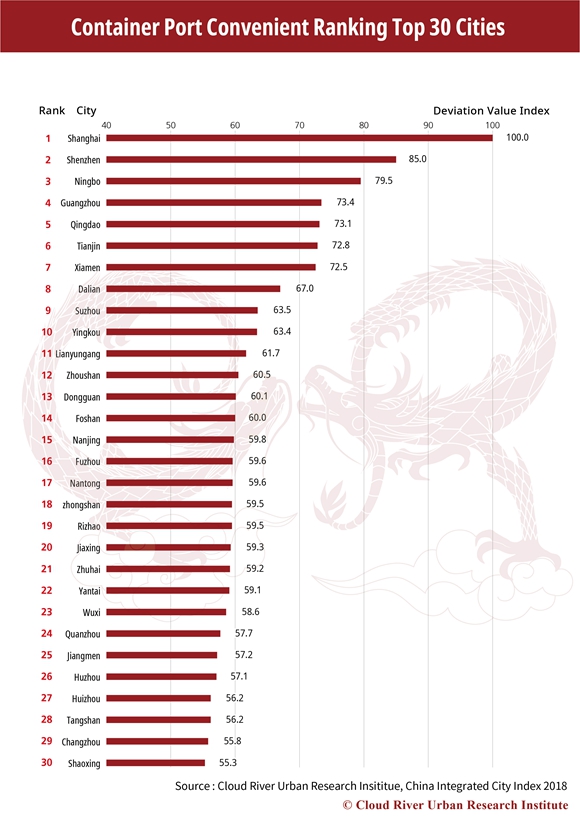'Polarization of driving forces' becomes a big trend for China's urban development
The spatial structure of China's economic growth is undergoing profound changes, with urban development showing obvious signs of "concentration" and "divergence."
Top 30 Cities Catering and Hotel Radiation
Shanghai, Beijing and Chengdu top the catering and hotel radiation ranking, and are followed by Guangzhou, Shenzhen, Hangzhou, Suzhou, Sanya, Xi'an and Xiamen. The top 10 in total house 35.7% and 77.1% of China's five-star hotels and international luxury restaurants, while the top 30 altogether take 61.1% and 91.8% of the country's total. Therefore, this also represents a high concentration of luxury restaurants and hotels in higher ranking cities.
Based on studies of the China Integrated City Index 2018, Cloud River Research Institute also found very high correlations between IT industry radiation and catering and hotel radiation, with correlation coefficient at 0.9. This may be explained by the fact that communications among high-income and broad-minded IT professionals are often found at dinner tables.
It may be no coincidence that the top seven cities by IT industry radiation, namely Beijing, Shanghai, Shenzhen, Chengdu, Hangzhou, Nanjing and Guangzhou, are also famous for their food culture, which undoubtedly could contribute to the people's communications and exchanges.
On the contrary, there is only a 0.68 correlation coefficient between the manufacturing radiation ranking and the catering and hotel radiation ranking, showing smaller gourmet appeal to people in the manufacturing sector compared to those in the IT sector.

Top 30 Cities by Container Port Convenience
The top 10 cities by container port convenience, i.e. Shanghai, Shenzhen, Ningbo, Guangzhou, Qingdao, Tianjin, Xiamen, Dalian, Suzhou and Yingkou, altogether account for 82% of the country's overall container throughput, while the top 30 take 97.8%. In other words, almost all of the country's container throughput are handled by the top 10% in the port convenience ranking.
Drawing on research findings of 298 cities at prefecture level and above from China Integrated City Index 2018, Cloud River Research Institute also found high correlations between the city's export volume in goods and the container port throughput, with correlation coefficient at 0.81. Moreover, 24 of the top 30 cities by manufacturing radiation are also among the top 30 cities by container port convenience. This shows that the manufacturing industry, especially those involved in exporting trade, depends heavily on the port environment. In this sense, China's export-oriented manufacturing is expected to be increasingly concentrated in well-established port cities.
In view of the high correlations between industrial development and port environment, China needs to learn lessons from the inefficient and decentralized industrial development in the past, and explore new ways for high-quality development in the future.

Top 30 Cities by Airport Convenience
The top 10 cities by airport convenience, i.e. Shanghai, Beijing, Guangzhou, Shenzhen, Chengdu, Kunming, Chongqing, Hangzhou, Xi'an and Xiamen, account for a combined 49.9% of the country's total passenger throughput and 73.5% the cargo throughput, while the top 30 cities took 81.3% and 92.9% respectively. Therefore, the big majority of China's passenger and logistic flows is highly concentrated in the top 10% cities by airport convenience.
Again, the institute found a high correlation between a city's IT industry radiation and airport convenience, with correlation coefficient at 0.82. Moreover, 21 cities among the top 30 cities by the IT industry radiation were also among the top 30 cities by airport convenience. This shows that the development of the IT industry hinges much on highly efficient airport facilities, and the industry is expected to further cluster into cities with more convenient airport networks.

Today, China's GDP, DID population and various other functions are increasingly concentrated in a handful of big cities, megacities, as well as megalopolises, and the trend is getting stronger. Therefore, improving the economic and space structure of these big cities, megacities and megalopolises is key to China's high-quality development.

